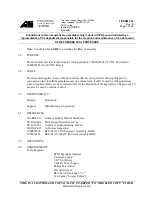
DMU380SA Series
User’s Manual
________________________________________________________________________
Doc# 7430-0026 Rev.01
Page 21
4
Theory of Operation
This section of the manual covers detailed theory of operation for each member of the
DMU380SA Series starting with the basic IMU380SA and then reviewing each major
variant (VG, AHRS and INS) with their associated additional features, outputs, and
performance. Table 7 shows the basic features of each member of the DMU380SA Series
with cross references to important sections for review.
Table 7.
DMU380SA Series Overview
Product
Features
Learning More
IMU380SA
6- DOF Digital IMU
Read 4.1 and 4.2
VG380SA
6-DOF IMU, plus Dynamic Roll/Pitch (optional external
GPS)
Read 4.1, 4.2 and 4.3
AHRS380SA
6-DOF IMU with 3-Axis Internal Magnetometer Dynamic
Roll, Pitch, and Heading (Optional External GPS)
Read 4.1, 4.2, 4.3 and 4.4
INS380SA
6-DOF IMU with 3-Axis Internal Magnetometer, and
Internal WAAS Capable GPS Receiver
Position, Dynamic Velocity, and Dynamic Roll, Pitch,
Heading
Read 4.1, 4.2, 4.3, 4.4 and 4.5
Figure 13 shows the DMU380SA Series hardware block diagram. At the core of the
DMU380SA Series is a rugged 6-DOF (Degrees of Freedom) MEMS inertial sensor
cluster that is common across all members of the DMU380SA Series. The 6-DOF MEMS
inertial sensor cluster includes three axes of MEMS angular rate sensing and three axes of
MEMS linear acceleration sensing. These sensors are based on rugged, field proven
silicon bulk micromachining technology. Each sensor within the cluster is individually
factory calibrated using MEMSIC
’s
automated manufacturing process. Sensor errors are
compensated for temperature bias, scale factor, non-linearity and misalignment effects
using a proprietary algorithm from data collected during manufacturing. Accelerometer,
rate gyro, and magnetometer sensor bias shifts over temperature (-40
0
C to +71
0
C) are
compensated and verified using calibrated thermal chambers and rate tables. The 6-DOF
sensor cluster data is fed into a high-speed microprocessor. The processor outputs attitude
and navigation data via the RS-232 port. As shown in the block diagram (Figure 13), the
INS380SA and AHRS380SA include an internal 3-axis magnetometer, and the
INS380SA includes an internal WAAS capable GPS receiver. In addition, the
AHRS380SA and VG380SA can accept input from external GPS sources as noted in
Chapter 2 of this manual.
















































